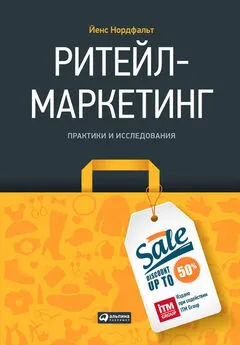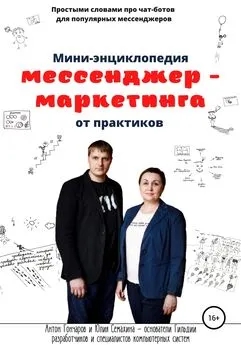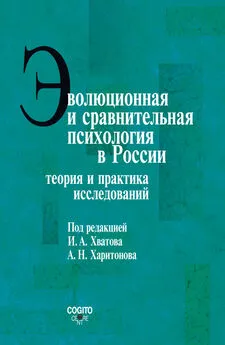Йенс Нордфальт - Ритейл-маркетинг: Практики и исследования
- Название:Ритейл-маркетинг: Практики и исследования
- Автор:
- Жанр:
- Издательство:Литагент Альпина
- Год:2015
- Город:Москва
- ISBN:978-5-9614-3935-9
- Рейтинг:
- Избранное:Добавить в избранное
-
Отзывы:
-
Ваша оценка:
Йенс Нордфальт - Ритейл-маркетинг: Практики и исследования краткое содержание
Ритейл-маркетинг: Практики и исследования - читать онлайн бесплатно ознакомительный отрывок
Интервал:
Закладка:
Повышение удовлетворенности потребителей
Другой тип маркетинга отношений, который обсуждается Форнеллом, опирается на увеличение удовлетворенности потребителей, что в свою очередь рассматривается как инструмент формирования лояльной потребительской базы. В данном случае идея состоит в том, чтобы работать с так называемыми мотиваторами и превосходить ожидания клиентов, чтобы стать для них предпочитаемой альтернативой. Ключевым элементом этой стратегии часто выступают сотрудники, взаимодействующие с клиентами. Одним из ярких сторонников этого подхода является известный ритейлер Фергал Куинн с его книгой «Коронуя покупателя» и сетью супермаркетов Superquinn в Ирландии. Куинн говорит, что его подход основан на принципе бумеранга, согласно которому основная задача персонала – сделать так, чтобы покупатель захотел вернуться. Он считает это даже более важным, чем взять с покупателя плату за купленные товары.
Ритейл-среда
Я хотел бы добавить третий подход к двум вышеописанным разновидностям маркетинга отношений. Этот подход сосредоточен на ритейл-среде с точки зрения того, насколько эта среда способствует установлению эффективных отношений с покупателями.
Дело в том, что покупательский опыт, ведущий к высокому уровню удовлетворенности, необязательно требует социальных взаимодействий. Многие посещения магазина предполагают минимальное взаимодействие покупателей с персоналом. Тем не менее я считаю, что между этими покупателями и магазином существуют определенные отношения. Обсуждению методов формирования такого типа отношений в существующей литературе уделяется крайне мало внимания. Я надеюсь, что эта книга в целом, и особенно главы 7–10 , в некоторой степени заполнят имеющийся пробел.
Библиография
Adaval, Rashmi and Kent B. Monroe (1995), «The Moderating Effects of Learning Goals and the Acquisition of Product Information on the Limits of Price Acceptability», Advances in Consumer Research, 22, 225–229.
Adaval, Rashmi and Kent B. Monroe (2002), «Automatic Construction and Use of Contextual Information for Product and Price Evaluations», journal of Consumer Research, 28, March, 572–588.
Ailawadi, Kusum L., J. P. Beauchamp, Naveen Donthu, Dinesh K. Gauri, and Venkatesh Shankar (2009), «Communication and Promotion Decisions in Retailing, A Review and Directions for Future Research», Journal of Retailing, 85, 1, 42–55.
Ailawadi, Kusum L., Bari A. Harlam, Jacques Cesar, and David Trounce (2006), «Promotion Profitability for a Retailer: The Role of Promotion, Brand, Category, and Store Characteristics», J ournal of Marketing Research, 43, 518–535.
Ailawadi, Kusum L., Donald R. Lehmann, and Scott A. Neslin (2001), «Market Response to a Major Policy Change in the Marketing Mix: Learning from Procter & Gamble’s Value Pricing Strategy», Journal of Marketing, 65, January, 44–61.
Ajzen, leek and Martin Fishbein (1980), Understanding Attitudes and Predicting Social Behavior, Englewood Cliffs, NJ Prentice Hall.
Alba, Joseph W., Susan M. Broniarczyk, Terence A. Shimp, and Joel E. Urbany (1994), «The Influence of Prior Beliefs, Frequency Cues, and Magnitude Cues on Consumers’ Perceptions of Comparative Price Data», Journal of Consumer Research, 21, September, 219–235.
Alba, Joseph W. and Amitava Chattopadhyay (1985), «Effects of Context and Part-Category Cues on Recall of Competing Brands», journal of Marketing Research, 22, August, 340–349.
Alba, Joseph W. and Amitava Chattopadhyay (1986), «Salience Effects in Brand Recall», Journal of Marketing Research, 23, November, 363–369.
Allenby, Greg M. and James L. Ginter (1995), «The effects of in-store displays and feature advertising on consideration sets», International Journal of Research in Marketing, 12, 67–80.
Allenby, Greg M. and Peter J. Lenk (1995), «Reassessing Brand Loyalty, Price Sensitivity, and Merchandising Effects on Consumer Brand Choice», Journal of Business and Economic Statistics, 13, 3, 281–289.
Alpert, Judy I. and Mark I. Alpert (1990), «Music influences on mood and purchase intentions», Psychology & Marketing, 7, 2, summer, 109–133.
Anderson, Evan E. and Henry N. Amato (1973), «A mathematical model for simultaneously determining the optimal brand-collection and display area allocation», Operations Research, 13–21.
Andrus, David (1986), «Office atmospherics and dental service satisfaction», Journal of Professional Services Marketing, 1, summer, 77–85.
Areni, Charles S., Dale F. Duhan and Pamela Kiecker (1999), «Point-of-purchase displays, product organization and brand purchase likelihoods», Journal of the Academy of Marketing Science, 27, 4, 428–441.
Areni, Charles S. and David Kim (1994), «The influence of in-store lightning on consumers’ examination of merchandise in a wine store», International Journal of Research in Marketing, 11, 2, 117–128.
Areni, Charles S. and David Kim (1993), «The influence of background music on shopping behavior: Classical versus top-forty music in a wine store», Advances in Consumer Research, 20, 336–340.
Argo, Jennifer J., Darren W. Dahl, and Rajesh W. Manchanda (2005), «The Influence of a Mere Social Presence in a Retail Context», Journal of Consumer Research, 32, 207–212.
Argo, Jennifer J., and Kelley J. Main (2008), «Stigma by Association in Coupon Redemption: Looking Cheap because of Others», Journal of Consumer Research, 35, December, 559–572.
Arnold, Mark, J. and Kristy E. Reynolds (2009), «Affect and Retail Shopping Behavior: Understanding the Role of Mood Regulation and Regulatory Focus «Journal of retailing, 85, 3, 308–320.
Arnold, Steven, Tae Oum and Douglas Tigert (1983), «Determinant attributes in retail patronage: Seasonal, temporal, regional and international comparisons», Journal of Marketing Research, 20, May, 149–157.
d’Astous, Alain (2000), «Irritating aspects of the shopping environment», Journal of Business Research, 49, 149–156.
Babin, Barry J. and Jill S. Attaway (2000), «Atmospheric affect as a tool for creating value gaining share of customer», Journal of Business Research, 49, 91–99.
Babin, Barry J., David M. Hardesty and Tracy A. Suter (2003), «Color and shopping intentions: The intervening effect of price fairness and perceived affect», journal of Business Research, 56, 541–551.
Baddeley, Alan D. (1993), Your memory: A user’s guide, London: Multimedia Books Ltd.
Bailey, Nicole and Charles Areni (2006), «When a few minutes sound like a lifetime: Does atmospheric music expand or contract perceived time?», Journal of Retailing, 82, 3, 189–202.
Baker, Julie, Michael Levy and Dhruv Grewal (1992), «An experimental approach to making retail store environmental decisions», Journal of Retailing, 68, A, 445–460.
Baker, Julie, A. Parasuraman, Dhruv Grewal and Glenn B. Voss (2002), «The influence of multiple store environment cues on perceived merchandise value and patronage intensions», Journal of Marketing, 66, 2, 120–141.
Bandyopadhyay, Subir (2009), «A dynamic model of cross-category competition, theory, test and applications», Journal of retailing, 85, 4, 468–479.
Bargh, John A. (1989), «Conditional automaticity: Varieties of automatic influence in social perception and cognition», Unintended thought, Uleman, J. S., and J. A. Bargh (ed.), New York: The Guilford Press, 3 – 51.
Bargh, John A., P. M. Gollwitzer, A. Lee-Chai, K. Barndollar and R.Trotschel (2001), «The automated will: Noncon-scious activation and pursuit of behavioral goals Journal of Personality and Social Psychology, 81, December, 1014–1027.
Baron, R. M. and D. A. Kenny (1986), «The moderator-mediator variable distinction in social psychological research: Conceptual, strategic, and statistical considerations», Journal of Personality and Social Psychology, SI, 6, 1173–1182.
Barone, Michael J., and Tirthankar Roy (2010), «Does Exclusivity Always Pay Off? Exclusive Price Promotions and Consumer Response», Journal of Marketing, 74, March, 121–132.
Barth, K. (1993), Betriebswirtschaftslehre des Handels.
Wiesbaden: Gabler. Basuroy, Suman, Murali K. Mantrala, and Rockney G. Walters (2001), «The impact of category management on retailer prices and performance: Theory and evidence», Journal of Marketing, 65, October 16–32.
Bawa, Kapil, Jane T. Landwehr, and Aradhna Krishna (1989), «Consumer response to retailers’ marketing environments: An analysis of coffee purchase data», Journal of Retailing, 65, 4, 471–495.
Bayley, Geoff and Clive Nancarrow (1998), «Impulse purchasing: A qualitative explanation of the phenomenon», International Journal of Qualitative Market Research, 1, 2, 99 – 114.
Bellizzi, Joseph A., Ayn E. Crowley, and Ronald W. Hasty (1983), «The effects of color in store design», Journal of Retailing, 59, 21–45.
Bellizzi, Joseph A. and Robert E. Hite (1992), «Environmental color, consumer feelings, and purchase likelihood», Psychology & Marketing, 9 (5, September/October), 347–363.
Bemmaor, Albert C. and Dominique Mouchoux (1991), «Measuring the short-term effect of in-store promotion and retail advertising on brand sales: A factorial experiment», Journal of Marketing Research, 28, May, 202–214.
Berne, Carmen, Jose M. Mugica, Marta Pedraja, and Pilar Rivera (2001), «Factors involved in price information-seeking behavior», Journal of Retailing and Consumer Services, 8, 71–84.
Bettman, J. R., M. F. Luce, and J. W. Payne (1998), «Constructive consumer choice processes», Journal of Consumer Research, 25, December, 187–217.
Beverland, Michael, Elison Ai Ching Lim, Michael Morrison, and Mile Terzovski (2006), «In-store music and consumer-brand relationships: Relational transformation following experiences of (mis)fit», Journal of Business Research, 59, 982–989.
Bezawada, Ram, S. Balachander, P. K. Kannan, and Venkatesh Shankar (2009), «Cross Category Effects of Aisle and Display Placements: A Spatial Modeling Approach and Insights», Journal of Marketing, 73, May, 99 – 117.
Читать дальшеИнтервал:
Закладка:










